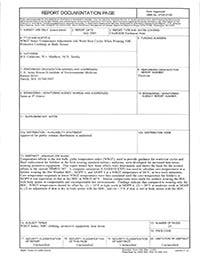
MILITARY HEAT STRESS RESEARCH
Cross Validation of US Army Research Institute of Environmental Medicine Heat Stress Prediction Models
The U.S. Army Research Institute of Environmental Medicine (USARIEM) has developed a heat model (ARIEM) using empirically derived equations to predict physiological responses of persons during heat exposure (8,9,22). The ARIEM model is composed of individual predictive equations for rectal temperature, heart rate and sweat loss. Input required for model prediction includes energy expenditure, environmental conditions, and clothing ensemble. Further modifying factors which have been included in refining the model are state of heat acclimation, solar load, cardiorespiratory fitness, gender and hydration state. The rectal temperature equations of the model predict a final equilibrium core temperature for any given set of environment, exercise and clothing conditions. This final equilibrium core temperature may be outside human physiological limits in extreme environments.
Heat Stress Management in the Military: Wet-Bulb Globe Temperature Offsets for Modern Body Armor Systems
Military training and operational activities often involve physically demanding work while wearing protective clothing systems in various environments. Consequently, body core temperature elevation and the risk of heat-related injury are critical operational concerns for safety and performance. Ballistic protection is commonly worn by military personnel on the torso and extremities. The materials comprising body armor are thick and impermeable, which increases thermal insulation and evaporative resistance and impairs heat loss from the body. Numerous studies have shown that heat strain is elevated when wearing military body armor systems. A limitation of these studies is that only trials in uncompensable heat stress conditions or time to exhaustion trials have been performed. This approach informs on the physiological strain of specific work intensities and environmental conditions between different body armor systems. Unfortunately, the ability to extrapolate these outcomes to broader conditions is limited. Moreover, inter-study differences in environment, work, body surface area coverage, and population characteristics have not provided a consistent avenue to compare different systems.
Measuring wet bulb globe temperatures at point of exertion in worldwide UK military settings: a longitudinal observational study determining the accuracy of a portable WBGT monitor
Heat illness among the UK Armed Forces is usually exertional, and therefore preventable, yet the incidence has not reduced since 2011. JSP 539 explicitly states that wet bulb globe temperature (WBGT) should be measured ’at the location of greatest heat risk’, not ’that of most convenience’. A handheld WBGT tracker used at point-of-exertion could reduce this incidence if proven to be as accurate as the current in-service device.
WBGT Index Temperature Adjustments for Work/Rest Cycles When Wearing NBC Protective Clothing or Body Armor
Temperature offsets to the wet bulb, globe temperature index (WBGT), used to provide guidance for work/rest cycles and fluid replacement for Soldiers in the field wearing standard military uniforms, were developed for increased heat stress wearing protective equipment. This report details how those offsets were determined, and shows the basis for the revised offsets in the current TBMED 507. A computer simulation (USARIEM-EXP) was used to calculate core temperatures in a Soldier wearing the Hot Weather BDU, MOPP 1, and MOPP 4 at a WBGT temperature of 86°F, at two work intensities. Core temperature responses at lower WBGT temperatures were then simulated until the core temperature for Soldiers in MOPP 4 was equivalent to that in the BDU at WBGT 86°F. Similar comparisons were made for soldiers wearing the BDU with body armor in compensable and uncompensable hot environments. Findings indicate that compared to wearing only the BDU, WBGT temperatures should be offset by: (1) + 10° F at light work in MOPP 4, (2) + 20°F at moderate work in MOPP 4, (3) no adjustment if skin is dry in body armor with the BDU, and (4) + 5° F if skin is wet in body armor with the BDU.




